|
|
Aug. 6, 2019

American Peat Technology (APT) is adding new equipment to its fleet that will extend its harvest season from eight weeks to eight months to further its competitive advantage in the global peat market. Through a bank participation loan with Iron Range Resources & Rehabilitation, the Aitkin-based company secured a custom-built excavator that is configured with float-based sectional barges designed to operate over swampy and water-based surfaces.
Prior to the new equipment, APT has harvested peat in January and February when temperatures are well below freezing allowing winter roads to be built across the frozen peat surface. The new equipment will float on water during the warmer months and eliminate the need for winter roads.
The new equipment will excavate thousands of yards of raw peat and transport it back to the APT plant where the peat is dewatered, dried and transformed into a granular product. It is then sold to the agricultural market for use as a carrier for nitrogen-fixing bacteria that improves yields for crops such as peanuts, soybeans, lentils, field peas and alfalfa. APT also has another granular peat product line that is used by industries requiring water treatment to remove heavy metals from water.
|
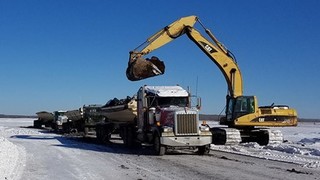
“Demand for peat has increased over the past several years,” said Doug Green, APT president. “We produced 785 truckloads of peat in 2018 and will produce about 1000 truckloads in 2019. The new equipment will enable us to produce up to 1400 truckloads.”
Peat is a natural organic material composed of partially decayed plant matter. It is found in specific bog ecosystems around the globe, including in the northern United States, Canada and northern Europe. Minnesota has one of the largest peat deposits in the United States. APT is currently permitted to harvest peat on 480-acres in Spencer Township in Aitkin County. Peat is considered a “slowly-renewable” resource and is not only used as a microbial carrier, but also as a soil amendment. It is also used as an energy and fuel source in parts of Europe.
APT was founded in 2003 by a group of partners. The majority of the partners are local residents, and eight of the partners are APT employees. The group purchased the assets of a former business known as Peat Technologies, began operating as APT in 2004 and now has approximately 43 fulltime employees. The company works closely with the Minnesota Department of Natural Resources, Minnesota Pollution Control Agency and Aitkin County Environment Services for permitting its operations and reclaiming post-harvested peatland back into peat-producing ecosystems. APT revegetates the harvested area and creates a shallow water wetland.
|
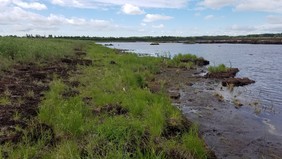
“The loan from Iron Range Resources & Rehabilitation enabled us to acquire custom equipment at a much lower cost due to the low interest rate,” said Green. “We can meet our customers’ growing demands by harvesting peat at a much more rapid rate and in much greater volumes.”
Note: Iron Range Resources & Rehabilitation provided American Peat two prior loans for start-up and research.
Pictured above from top to bottom are: peat granules, peat harvesting on winter roads and a reclamation pond.
|
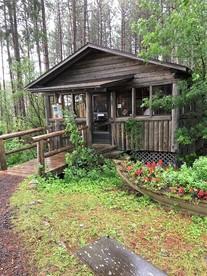
The Dorothy Molter Museum received a Culture & Tourism grant to install new temperature and moisture-resistant flooring in two of its historic 80-year old cabins that belonged to and house artifacts from Dorothy’s actual home on Knife Lake in the Boundary Waters Canoe Area Wilderness (BWCAW). The old vinyl flooring had crumbled due to seasonal foundation shifting.
Dorothy was the last non-indigenous resident of the BWCAW. A licensed nurse from Chicago, she first visited Isle of Pines resort on Knife Lake with family members in 1930 at age 23. As her annual visits with family continued, she developed a friendship with resort owner Bill Berglund based on their mutual love of the wilderness. Eventually Dorothy would reside on the island year round to assist Mr. Berglund with resort operations and maintenance, as well as provide his nursing care as his health declined. He passed away in 1948, and his family deeded the resort to Dorothy. She began making homemade root beer after the flight ban of 1949 and sold it to thousands of canoeists and visitors to her resort earning her the name Root Beer Lady.
|
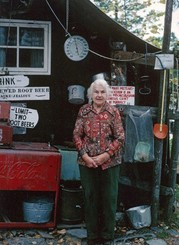
Dorothy gained national media attention beginning in 1952 due to her unorthodox lifestyle, and that attention culminated with the passing of the 1964 Wilderness Act and a successful petition to the federal government urging the United States Forest Service to allow her to stay on her property until her death. She passed away at age 79 and was the last living occupant of the 2 million acre BWCAW. Read her full biography here.
The museum, located on the east end of Ely, features an interpretive center and gift shop and three of Dorothy’s original cabins housing a variety of exhibits including her root beer making equipment. It is open daily through Labor Day and attracts approximately 5,000 visitors each season. For Culture & Tourism grant information email Danae Beaudette or call her at 218-735-3022.
Pictured above:
The Winter Cabin: Dorothy's primary residence when on Isle of Pines.
Dorothy Molter on Isle of Pines.
|

Deerwood
Deerwood Civic & Commerce received a Culture & Tourism grant which helped complete the funding to construct a new community splash pad in Deerwood’s city park. The water play area is free to use for people of all ages and is in close proximity to a picnic pavilion and playground, making it a great spot for a family outing on a warm summer day. The pad offers local residents healthy recreation which is important to our region’s quality of life. Deerwood is located about 10 minutes from Cuyuna Country State Recreation Area that attracted 185,000 visitors last year. The city anticipates many of those tourists and biking families to make a stop at the splash pad.
|
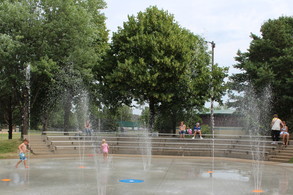
Hibbing
Hibbing Foundation received a Culture & Tourism grant to assist with a new splash pad in Bennett Park that is 100% handicap accessible and open to the public daily from 11 a.m. to 7 p.m. The new amenity features a seating area for parents and grandparents to watch their children play. Located adjacent to the water play area are restrooms and a pavilion with tables and chairs.
Hibbing recently updated its comprehensive plan. A community survey was conducted in the process, and a common theme emerged for maintaining and advancing the city’s quality of life components such as housing, parks, recreation and access to natural resources.
For Culture & Tourism grant information email Danae Beaudette or call her at 218-735-3022.
|

Iron Range Resources & Rehabilitation invests resources to foster vibrant growth and economic prosperity in northeastern Minnesota. The Downtown Streetscapes grant program began accepting applications on August 1 for the fiscal year 2020 funding cycle. The program assists with incentivizing investment in downtown areas and business corridors through projects that promote safe and attractive environments for residents, shoppers, workers and visitors. Project examples include:
- Public utility box mural wraps.
- Pocket park.
- Benches, outdoor patio, picnic table, gazebo.
- Walking paths and sidewalk renovations with information kiosks and signage.
- Building façade murals.
- Bike racks.
We encourage eligible applicants in our service area to apply. Click here to learn more and view the grant guidelines. Access the grant application portal (FLUXX) by clicking here. Iron Range Resources & Rehabilitation funds its grants programs through taxes paid by Minnesota’s mining industry.
|
|
|
|
|
|
The Ranger is a publication of Iron Range Resources & Rehabilitation. Our mission is to invest resources to foster vibrant growth and economic prosperity in northeastern Minnesota.
|
|